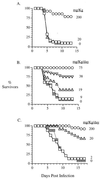Activity of pleconaril against enteroviruses
- PMID: 10471549
- PMCID: PMC89431
- DOI: 10.1128/AAC.43.9.2109
Activity of pleconaril against enteroviruses
Abstract
The activity of pleconaril in cell culture against prototypic enterovirus strains and 215 clinical isolates of the most commonly isolated enterovirus serotypes was examined. The latter viruses were isolated by the Centers for Disease Control and Prevention during the 1970s and 1980s from clinically ill subjects. Pleconaril at a concentration of </=0.03 microM inhibited the replication of 50% of all clinical isolates tested. Ninety percent of the isolates were inhibited at a drug concentration of </=0.18 microM. The most sensitive serotype, echovirus serotype 11, was also the most prevalent enterovirus in the United States from 1970 to 1983. Pleconaril was further tested for oral activity in three animal models of lethal enterovirus infection: coxsackievirus serotype A9 infection in suckling mice, coxsackievirus serotype A21 strain Kenny infection in weanling mice, and coxsackievirus serotype B3 strain M infection in adult mice. Treatment with pleconaril increased the survival rate in all three models for both prophylactic and therapeutic dosing regimens. Moreover, pleconaril dramatically reduced virus levels in target tissues of coxsackievirus serotype B3 strain M-infected animals. Pleconaril represents a promising new drug candidate for potential use in the treatment of human enteroviral infections.
Figures




Similar articles
-
Anti-enteroviral triple combination of viral replication inhibitors: activity against coxsackievirus B1 neuroinfection in mice.Antivir Chem Chemother. 2015 Dec;24(5-6):136-147. doi: 10.1177/2040206616671571. Epub 2016 Nov 4. Antivir Chem Chemother. 2015. PMID: 27815331 Free PMC article.
-
Clinical activity of pleconaril in an experimentally induced coxsackievirus A21 respiratory infection.J Infect Dis. 2000 Jan;181(1):20-6. doi: 10.1086/315176. J Infect Dis. 2000. PMID: 10608746 Clinical Trial.
-
Effect of Consecutive Alternating Administration of a Triple Combination of Anti-Enteroviral Compounds in Mice Infected with Coxsackievirus B3.Pathog Dis. 2020 Nov 23;78(9):ftaa065. doi: 10.1093/femspd/ftaa065. Pathog Dis. 2020. PMID: 33090201
-
Pleconaril. A broad spectrum antipicornaviral agent.Adv Exp Med Biol. 1999;458:69-76. Adv Exp Med Biol. 1999. PMID: 10549380 Review. No abstract available.
-
Pleconaril--an advance in the treatment of enteroviral infection in immuno-compromised patients.J Clin Virol. 2005 Jan;32(1):1-6. doi: 10.1016/j.jcv.2004.06.006. J Clin Virol. 2005. PMID: 15571999 Free PMC article. Review.
Cited by
-
Novel capsid binder and PI4KIIIbeta inhibitors for EV-A71 replication inhibition.Sci Rep. 2021 May 6;11(1):9719. doi: 10.1038/s41598-021-89271-8. Sci Rep. 2021. PMID: 33958691 Free PMC article.
-
Acute viral infections of the central nervous system in immunocompetent adults: diagnosis and management.Drugs. 2013 Feb;73(2):131-58. doi: 10.1007/s40265-013-0007-5. Drugs. 2013. PMID: 23377760 Review.
-
Mutation in enterovirus 71 capsid protein VP1 confers resistance to the inhibitory effects of pyridyl imidazolidinone.Antimicrob Agents Chemother. 2004 Sep;48(9):3523-9. doi: 10.1128/AAC.48.9.3523-3529.2004. Antimicrob Agents Chemother. 2004. PMID: 15328120 Free PMC article.
-
Treatment of respiratory virus infections.Antiviral Res. 2006 Jun;70(2):1-16. doi: 10.1016/j.antiviral.2006.01.006. Epub 2006 Feb 14. Antiviral Res. 2006. PMID: 16513187 Free PMC article. Review.
-
Passive protection effect of chicken egg yolk immunoglobulins on enterovirus 71 infected mice.Vaccine. 2010 Nov 29;28(51):8189-96. doi: 10.1016/j.vaccine.2010.09.089. Epub 2010 Oct 29. Vaccine. 2010. PMID: 20937321 Free PMC article.
References
-
- Abdel-Rahman S M, Kearns G L. Single oral dose escalation pharmacokinetics of pleconaril (VP 63843) capsules in adults. J Clin Pharmacol. 1999;39:613–618. - PubMed
-
- Abzug M J, Levin M J, Rotbart H A. Profile of enterovirus disease in the first two weeks of life. Pediatr Infect Dis J. 1993;12:820–824. - PubMed
-
- Abzug M J. Perinatal enterovirus infections. In: Rotbart H A, editor. Human enterovirus infections. Washington, D.C: ASM Press; 1995. pp. 221–238.
-
- Badger J, Minor I, Kremer M J, Oliveira M A, Smith T J, Griffith J P, Guerin D M A, Krishnaswamy S, Luo M, Rossmann M G, McKinlay M A, Diana G D, Dutko F J, Fancher M, Rueckert R R, Heinz B A. Structural analysis of a series of antiviral agents complexed with human rhinovirus 14. Proc Natl Acad Sci USA. 1988;85:3304–3308. - PMC - PubMed
-
- Bailey T R, Diana G D, Kowalczyk P F, Akullian V, Eissenstat M A, Cutliffe D, Mallamo J P, Carabateas P M, Pevear D C. Antirhinoviral activity of heterocyclic analogs of Win 54954. J Med Chem. 1992;35:4628–4633. - PubMed
MeSH terms
Substances
LinkOut - more resources
Full Text Sources
Other Literature Sources

